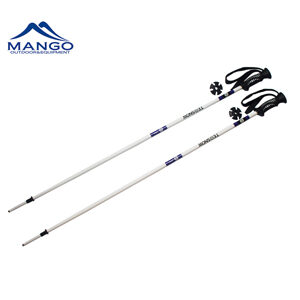When it comes to skiing, selecting the right ski pole is crucial for comfort, control, and overall performance on the slopes. Here’s a comprehensive guide to help you make an informed decision when choosing your ski poles:
1. Determine the Correct Length:
Choosing the correct length for your ski poles is essential. To find the right size, stand with your ski boots on and hold the poles upside down. Your elbows should form a 90-degree angle when the pole grips are on the ground. If the angle is too acute or too obtuse, adjust the pole length accordingly.
2. Consider the Material:
Ski poles are commonly made of aluminum, carbon fiber, or a combination of both. Aluminum poles are durable and affordable, making them suitable for beginners. Carbon fiber poles are lightweight and provide excellent vibration dampening, ideal for more experienced skiers. Consider your skiing style and budget when choosing the material.
3. Choose the Right Grip:
Ski pole grips come in various materials, including rubber, foam, and cork. Rubber grips are durable and provide good insulation, foam grips are lightweight and comfortable, while cork grips offer excellent moisture absorption and a natural feel. Consider your personal preferences and the climate in which you’ll be skiing when selecting the grip material.
4. Pick the Right Strap Style:
Ski pole straps come in different styles, including traditional loop straps and adjustable wrist straps. Traditional loop straps are simple and effective, while adjustable wrist straps provide more customization. Choose a style that feels secure and comfortable, allowing you to maintain control without causing discomfort.
5. Select the Basket Size:
The basket at the bottom of the ski pole prevents it from sinking too deeply into the snow. Choose a basket size based on the type of skiing you’ll be doing. Larger baskets are suitable for powder skiing, providing more surface area to prevent sinking. Smaller baskets are ideal for groomed trails and hard-packed snow.
6. Consider Additional Features:
Some ski poles come with additional features such as adjustable lengths, collapsible designs for easy storage, and integrated shock absorption systems. Evaluate these features based on your preferences and the type of skiing you plan to do. Adjustable poles, for example, are versatile and can be adapted for different terrains.
Conclusion
Choosing the right ski pole involves considering factors such as length, material, grip, strap style, basket size, and additional features. By taking the time to assess your individual needs and preferences, you can select ski poles that enhance your skiing experience and contribute to better control and comfort on the slopes.
Contact our team today if you have any questions at all. We are always really keen to help in any way that we can.


